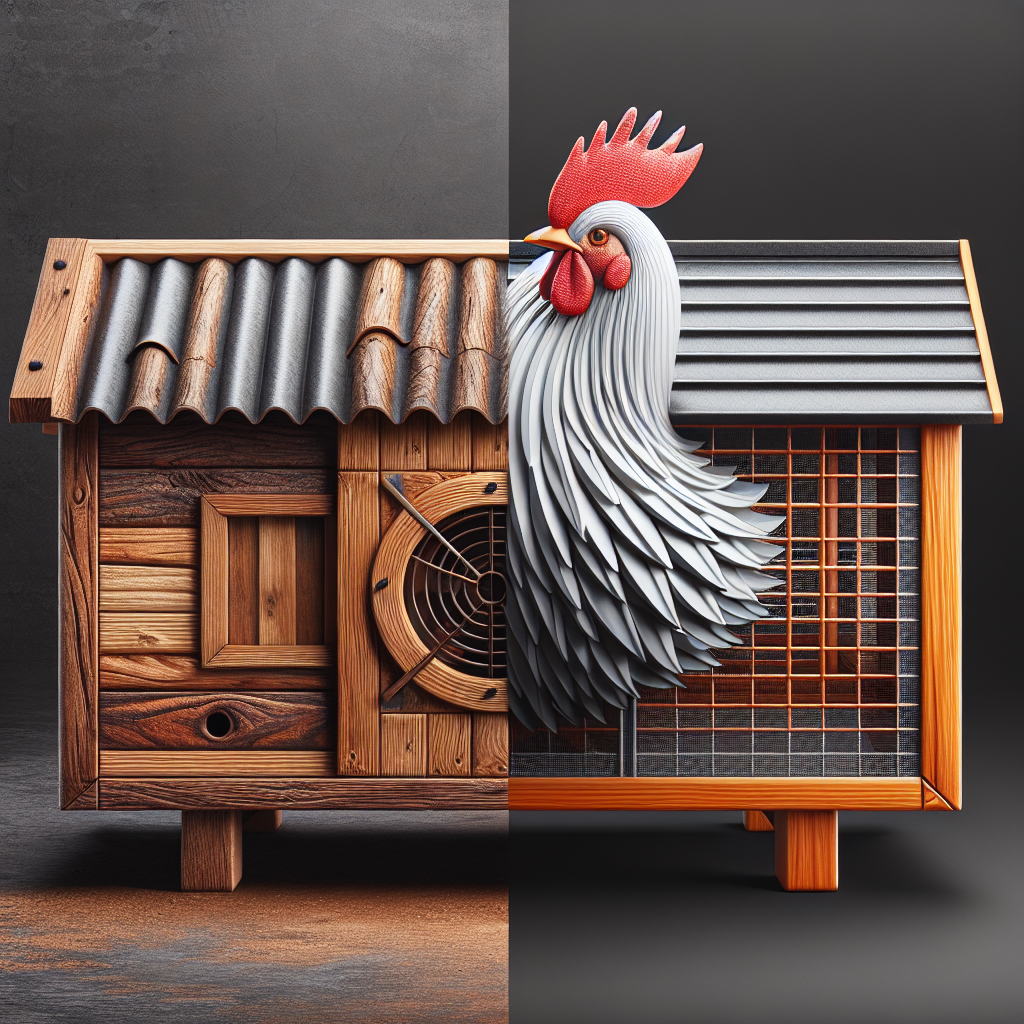If you’re considering building a chicken coop and want to make environmentally-conscious choices, you may be wondering if there are sustainable or recycled materials that are suitable for construction. With increasing awareness about the importance of sustainable practices, it’s no surprise that many people are seeking alternatives in construction. In this article, we’ll explore the options available for building a chicken coop using sustainable or recycled materials, allowing you to create a comfortable home for your feathered friends while reducing your ecological footprint.
Sustainable Materials for Chicken Coop Construction
When it comes to building a chicken coop, using sustainable materials can have a positive impact on the environment while providing a safe and comfortable space for your feathered friends. By opting for sustainable materials, you are reducing your carbon footprint and contributing to a more eco-friendly future. In this article, we will explore the benefits of using sustainable materials for chicken coop construction and discuss various types of materials that you can consider.
Benefits of Using Sustainable Materials
Using sustainable materials for chicken coop construction offers a myriad of benefits. Firstly, it helps in conserving natural resources. By utilizing materials that are renewable or recycled, you are reducing the demand for new materials, thus preserving our limited natural resources. Moreover, it helps in reducing waste and promotes the concept of reusing and recycling materials.
Secondly, sustainable materials are often non-toxic and free from harmful chemicals. This is crucial for the well-being of your chickens, as they can be sensitive to certain substances. Using sustainable materials ensures that your coop is a safe and healthy environment for your feathered companions.
Furthermore, sustainable materials are known for their durability. These materials are designed to withstand various weather conditions and can last for a long time, reducing the need for frequent repairs or replacements. By choosing sustainable materials, you are investing in a long-term solution that provides stability and reliability.
Lastly, building with sustainable materials can also save you money in the long run. While the initial cost may be slightly higher than traditional materials, the longevity and durability of sustainable materials ensure that you won’t have to spend continuously on maintenance or replacements. Additionally, using sustainable materials can also enhance the aesthetic appeal of your chicken coop, adding a unique and beautiful touch to your backyard.
Types of Sustainable Materials
Now that we have explored the benefits, let’s delve into some of the most commonly used sustainable materials for chicken coop construction:
1. Recycled Wood
Recycled wood is an excellent choice for constructing a chicken coop. It is typically salvaged from old buildings, pallets, or other discarded wooden items. By repurposing this wood, you are preventing it from ending up in landfills while reducing the demand for new timber. Make sure to choose untreated or non-toxic recycled wood to ensure the health and safety of your chickens.
2. Bamboo
Bamboo is a highly sustainable material due to its rapid growth rate and renewability. It is known for its strength and is resistant to pests, making it an ideal choice for chicken coop construction. Bamboo also has a natural aesthetic appeal, adding a touch of elegance to your coop.
3. Straw Bales
Straw bales are another sustainable option for chicken coop construction. Not only are they readily available, but they also provide excellent insulation for your coop. Straw bales are known for their ability to regulate temperature, keeping your chickens warm during winter and cool during summer.
4. Hempcrete
Hempcrete, a mixture of hemp hurd and lime, is gaining popularity as a sustainable building material. It offers excellent thermal insulation, is fire-resistant, and has natural pest repellent properties. Hempcrete is not only environmentally friendly but also provides a healthier environment for your chickens.
5. Rammed Earth
Rammed earth is an ancient building technique that involves compressing a mixture of soil, clay, sand, and gravel. It is a durable and low-maintenance material that provides excellent insulation and natural cooling properties. Rammed earth is a sustainable choice for chicken coop construction due to its renewable nature and minimal environmental impact.
6. Cork
Cork is a versatile and sustainable material that can be used for various purposes, including chicken coop construction. It is harvested from the bark of cork oak trees, which can regenerate after being stripped. Cork offers natural insulation, is resistant to pests and fire, and is a renewable resource.
7. Recycled Plastic
Recycled plastic is a durable and low-maintenance material that can be repurposed for chicken coop construction. It is made from post-consumer plastic waste such as bottles and containers, helping to reduce plastic pollution. Recycled plastic materials are weather-resistant, long-lasting, and easy to clean, making them a practical choice.
8. Metal
Metal, such as steel or aluminum, is a sustainable option for chicken coop construction. It is highly durable, resistant to pests and weather conditions, and can be easily recycled at the end of its life span. Metal coops are known for their strength and longevity.
9. Glass
While not a commonly used material for the entire coop structure, glass can be incorporated into windows or skylights. Using recycled or salvaged glass not only adds natural light to the coop but also reduces the demand for new glass production. Glass is a beautiful and sustainable choice for enhancing the aesthetics of your chicken coop.
Now that we have explored sustainable materials, let’s dive into using recycled materials specifically for chicken coop construction.
Recycled Materials for Chicken Coop Construction
Recycled materials play a significant role in reducing waste and minimizing environmental impact. Incorporating recycled materials into your chicken coop construction not only benefits the planet but also adds character and uniqueness to your coop. Here are some recycled materials you can consider:
1. Salvaged Wood
Salvaged wood, as mentioned earlier, can be repurposed from old buildings, pallets, or furniture. Not only does it add a rustic charm to your coop, but it also reduces the need for new timber and prevents old wood from ending up in landfills.
2. Metal
Similar to sustainable construction, recycled metal can be used for building chicken coops. Scrap metal or salvaged metal products can be repurposed to create a sturdy and durable structure. Using recycled metal helps in conserving resources and reducing energy consumption required for metal production.
3. Recycled Plastic
Recycled plastic, as mentioned earlier, is a versatile material that can be repurposed for chicken coop construction. By using recycled plastic materials, you are preventing plastic waste from polluting the environment and contributing to the circular economy.
4. Rubber
Rubber, such as recycled tires or rubber mats, can be used for flooring in the chicken coop. It provides cushioning for your hens’ feet and is easy to clean. By repurposing rubber, you are reducing waste and giving new life to discarded materials.
5. Glass
Recycled or salvaged glass can be used for windows, skylights, or even as decorative elements in your chicken coop. Not only does it add a touch of elegance, but it also reduces the demand for new glass production, ultimately reducing energy consumption and environmental impact.
6. Concrete
Recycled concrete, known as crushed concrete or reclaimed concrete, can be used for the foundation or flooring of your chicken coop. It offers durability, strength, and reduces the need for new concrete production. By repurposing concrete, you are minimizing waste and conserving natural resources.
7. Reclaimed Bricks
Reclaimed bricks are salvaged from old buildings and can be used as an attractive and eco-friendly option for your chicken coop’s exterior. They add charm and character while reducing the demand for new brick production.
8. Old Windows and Doors
Repurposing old windows and doors not only adds a unique touch to your chicken coop but also prevents them from ending up in landfills. These salvaged items can provide ventilation and natural light to the coop, ensuring a comfortable and healthy environment for your chickens.
9. Scrap Metal
Similar to using recycled metal, repurposing scrap metal for various coop components can contribute to a more sustainable construction process. Whether it’s for doors, hardware, or fencing, utilizing scrap metal reduces waste and conserves resources.
10. Reused Building Materials
Finally, consider reusing various building materials from previous projects or renovations. This may include items such as nails, screws, plywood, or insulation materials. By repurposing these materials, you are reducing waste and making the most of what you already have.
In conclusion, whether you choose sustainable materials or opt for recycled materials, incorporating eco-friendly practices into your chicken coop construction is a commendable step towards a greener future. By considering the various options available and making conscious choices, you can create a comfortable and environmentally responsible space for your chickens while minimizing your impact on the planet. So, go ahead, build your chicken coop using sustainable or recycled materials and make a positive difference!




